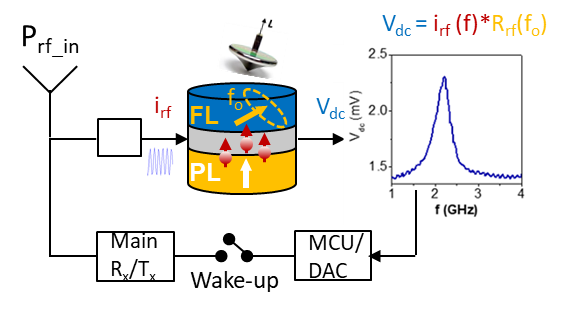
Principle of the RF-to-DC conversion: An incoming rf signal Prf_in can induce, via the spin transfer torque, an oscillation of the magnetization, that results in oscillations of the magneto-resistance Rrf. At resonance, i.e. when the excitation frequency f is equal to an internal mode frequency fo of the MTJ, the product Vdc=irf x Rrf contains a DC component that is large due to the large oscillation amplitude at resonance. This frequency selective RF-to-DC conversion is interest for the development of ultra-low power wake-up receivers, whose signal after demodulation is used to turn on the power hungry main Rx/Tx communication module when needed.
Spin-torque-nanodiodes based on magnetic tunnel junctions are promising candidates for RF energy harvesters and ultra-low power wake-up receivers with performances that are expected to surpass those of semiconductor diodes. Experiments on magnetic tunnel junctions with perpendicular magnetic anisotropy show how the performances can be optimized upon reducing the magnetic layer thickness and the device diameter.
Perpendicular magnetic tunnel junctions (pMTJs), whose free layer (FL) and polarizing layer (PL) are characterized by an interfacial perpendicular magnetic anisotropy (iPMA) are best known for their application as magnetic memories. SPINTEC demonstrated that these pMTJ devices show also good rf functionalities, such as the generation of coherent microwave signals or the frequency selective conversion of an incoming microwave signal into a DC voltage signal Vdc (see Figure). The good RF-to-DC conversion efficiency of these devices makes them of interest for RF energy harvesters or wake-up receivers (see Figure) that are implemented in wireless sensor networks to improve their autonomy and energy consumption.
SPINTEC demonstrated how the conversion efficiency of pMTJs can be optimized via the tuning of the magnetic layer thickness t and the nanopillar diameter D that determine the balance between the demagnetization and iPMA energies. Close to compensation, the amplitude of the resonance excitation and consequently the produced DC voltage Vdc is at its maximum. Furthermore, smaller diameters lead to higher current densities and through this to larger oscillation amplitudes. SPINTEC has experimentally verified these size dependencies for pMTJs, demonstrating largest signal levels in the mV range for diameters as small as 50nm.
In addition, it was shown that the detection frequency of these pMTJs can be tuned over several Gigahertz, upon adding a small DC current (1mA or less). This is attributed to Joule heating that affects the iPMA energy constant. Finally, an amplitude modulated, incoming signal could be successfully demodulated. For wake-up receivers this means that the information encoded in the amplitude of the wake-up signal can be directly decoded by the pMTJ and that via a DC current it is possible to reprogram the frequency bandwidth of communication. These properties will be exploited within the European project Swan-on-chip.
Teams: RF spintronics, MRAM, Theory and Simulation
Collaboration: Singulus, Thales TRT, G-INP/TIMA, INL
Funding: ANR SPINNET
Further reading: Size-dependent enhancement of passive microwave rectification in magnetic tunnel junctions with perpendicular magnetic anisotropy, A. Sidi El Valli , V. Iurchuk, G. Lezier, I. Bendjeddou, R. Lebrun, N. Lamard, A. Litvinenko, J. Langer, J. Wrona, L. Vila, R. Sousa, I. L. Prejbeanu , B. Dieny, and U. Ebels, Appl. Phys. Lett. 120, 012406 (2022).
Contact: Ursula Ebels




